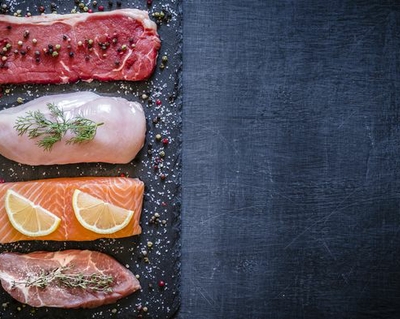You’ve probably noticed: Protein is having a bit of a moment right now. TikTok content creators promote their favorite protein powders and hacks to ensure you get your 200 grams of protein a day. Add in labels trumpeting protein gram counts on everyday foods, product documentaries and podcasters promoting their high-protein regimens, and it’s hard to miss the claim: High-protein means good health.

But is that really true? Experts like physician Dr. Rob Lejawa attest to the fact that some of these high-protein fads can be more harmful than helpful – like slamming a protein shake before a workout. “After a workout is when you should be consuming your protein,” he said. And 200 grams per day is much more than the average person needs.
Note to readers: While Americans don’t typically deal in grams when it comes to measurement, food labels all use that format.
With all of the noise around high-protein diets, supplements and powders, it can be difficult to tell fact from fad. So we recently sat down with Lejawa, a family medicine physician, to learn what a healthy daily dose of protein really looks like.
Have questions about what's right for you? Doctors have answers.
'High protein' is a phrase we hear a lot. What actually is a high-protein diet?
The recommendation “you just need a high-protein diet” drives me crazy because there’s no true definition for that across a population, aside from what literature shows is an average healthy amount.
Additionally, most patients I see find a lot of information about high-protein diets online and often come in with questions or a feeling of, “What does all of this information mean for me?”
My generic answer for what is considered high protein is 1-1.2g/kg for recreational, 1.2-1.6g/kg for endurance and 1.6-2.2g/kg for strength/power athletes.
Want to do your own math? Here’s a kg/pound converter.
One example: For a 154-pound woman who leads a sedentary lifestyle, a healthy amount of protein to consume per day would be roughly 56 grams.
How can high-protein diets be either healthy or unhealthy for us? Can they be both?
Yes, absolutely. One thing we see a lot in the high-protein diets, particularly, is restrictive diets or elimination diets. I want to emphasize: Restriction and elimination diets are not necessary for someone to get a healthy amount of protein. An elimination diet refers to one where certain foods are removed from one’s diet. A restrictive diet generally refers to someone significantly reducing calorie intake.
However, diets are not going anywhere, and an extreme example of a high-protein diet is the Carnivore Diet, which is an elimination diet. You only eat red meat. An elimination diet is fine under medical supervision, but it should be temporary. You could not maintain or sustain that diet indefinitely.
There is some research showing it can be healthy for some patients, particularly those with autoimmune disorders or those who have food sensitivities and have no idea what’s causing it. You eliminate most foods and re-implement them over time.
However, while you’re on the diet, you get none of your antioxidants, none of your fiber and none of your nutrients besides protein. The other extreme is being protein-deficient and overall malnourished. Healthy protein intake is somewhere in the middle.
There are some high-protein trends taking the internet by storm. Could you share your perspective on them?
The trend: The “30-30-30 rule” – Consuming 30 grams of protein within 30 minutes of waking up followed by 30 minutes of moderate activity.
The doctor’s take: This is a bad idea. You don’t want to consume anything that’s heavy protein pre-workout. Blood will be diverted to your GI tract instead of being able to assist your muscles.
The trend: Protein popcorn and other protein-enhanced snacks.
The doctor’s take: I’d rather you eat a healthier version of the snack than a processed food enhanced with extra protein. However, if the snack is the healthier alternative, or the lesser evil of two options, I’m all for it.
The trend: Mixing a vanilla protein shake with Diet Coke.
The doctor’s take: I do not recommend that for a few reasons. If you’re a soda drinker, I’d recommend trying to switch to something that can replace it, like sparkling water. If it’s the sweetness you're looking for, try a fruit smoothie with some greens. But back to the trend – if you want to drink the Diet Coke, drink the Diet Coke. But don’t think there’s something healthy happening just because it’s mixed with a protein shake.
This craze over protein seems to have two goals: Build muscle and lose weight. How can protein support both?
When you consume protein, your body breaks it down into amino acids. These are the “building blocks” of every protein. Those amino acids can contribute to muscle-building while you exercise. However, if you’re consuming protein and you don’t use it up by exercising, it doesn’t get converted into muscle – it gets converted into fat.
So, if your goal is to build muscle, drinking protein shakes every day is not going to be enough – you have to work out regularly, too. On the weight-loss side of things, protein-rich foods actually keep you full for longer. A healthy amount of protein in your diet can help you feel satisfied throughout your day.
Does the timing of your protein consumption matter?
It depends. There are some general rules: Don’t do it before a workout, but after a workout is fine. Don’t consume protein for a minimum of two hours before going to bed, because you may end up with difficulty sleeping, which can affect your sleep schedule, and sometimes cause GI distress. But it’s also about listening to your body. If you’re not hungry after a workout, don’t force yourself to consume protein.
Are there risks to a high-protein diet?
Yes. The two biggest risks are kidney dysfunction and coronary artery disease (CAD). Warning signs with these are difficult to identify early on. If you feel bad with those, it’s usually late in the game. You may feel fine until you get a routine blood draw at your annual exam and then you find out you’re dealing with kidney dysfunction.

If you’re going to go on a high-protein diet in the first place – particularly a restriction or elimination diet – you should be medically supervised. Red meat or low-quality cuts of meat are the biggest causes of weight gain, CAD, and heart or kidney disease.
Most of these issues are decades in the making, but we want to prevent them by monitoring where you’re getting protein and how we can improve kidney and heart function.
If you’re trying to start a high-protein diet, what’s the most important action you can take to prevent these issues?
Eat protein from a healthy source, including lean meats, eggs, beans and lentils and nuts and seeds. The biggest myth I hear is that you can’t build muscle through plant protein, and that couldn’t be further from the truth. You should also be seeing your primary care provider for annual checkups. They’ll do routine bloodwork so you can identify any issues early on.
Take the first step toward better back and neck health.
How does protein intake change as we age?
As our organs change, they usually don’t function as well, and it’s harder to maintain muscle mass, especially through weight training. As we age, weight training is more important than ever. Sometimes we may recommend a higher protein intake to keep the muscle mass you had at a younger age.
What’s your take on kids and teens consuming protein shakes or supplements?
The biggest concern I have is the continuing rise in body dysmorphic disorders (BDD) in both young men and women due to false expectations of how you should look. BDD is defined by spending a lot of time worried about flaws in appearance in a way that interferes with quality of life, and it’s already most common in teenagers and young adults.
Now that we have filters and curated peeks social media gives us into someone else’s life, it’s easy to see how a teenager could think, “I just need to load up on protein because everyone is doing it.”
However, it’s really about balance. I’d rather have teenagers engaging in movement and sports in an age where the vast majority of adolescents are leading inactive lifestyles. We just need to make sure they’re doing it in a healthy way with realistic expectations.
If someone wants to be more mindful about having a healthy, balanced protein intake, what should they focus on first?
I’d take an inventory of where you’re at now: What are you trying to do? Where are you currently?
Adjust protein accordingly: If you’re going to be working out more, add a little bit more to your diet (about 1-1.6 grams per kg of body weight from a good protein source). Or if you’re just trying to lose weight without adding in an exercise regimen, keep your protein intake at normal levels (0.8 grams p
The reason for the difference is that if you’re only trying to lose weight, but you don’t have an exercise regimen, your body will have fewer opportunities to convert that protein into muscle. Protein only gets transformed into new muscle when we exercise.
For those seeking weight loss solely, we want to avoid overdoing it on the protein and potentially adding excess fat. That’s what protein becomes if our bodies don’t use it. However, if you are working out more, that protein will become new muscle, and upping your protein intake a bit will help sustain a new level of activity.
You can get your protein from plant-based sources so you avoid the risk of heart disease. Focus on trying to find the healthiest sources of protein, not just anything you can find.
If you have any questions, always go to your physician.
If there’s truly no 'one-size-fits-all' answer for what is considered high-protein, how do you work with patients to tailor their diets to their needs?

In regard to protein, I look at how much protein someone is taking in compared to other macronutrients, like how much fat or carbohydrates, when I consider what a high-protein diet looks like for someone. I also want to individualize my care to lifestyle factors: A patient’s age, health, medical conditions, how active they are, and what type of activity they’re doing.
We can also discuss what type of activity the patient would like to be doing. If I meet someone who is currently not active but is ready to start training for a marathon, we do need to plan for diet changes.
It’s most important to me to meet patients where they’re at.
Tailoring diet and exercise
When we talk about exercise, I’d say everyone should be doing some type of endurance exercise. That can simply be walking, as long as you’re getting your heart rate up. And everyone needs to do some resistance training. That can be body-weight exercise at home or a workout program you do in the gym with weights.
When it comes to individualized planning, depending on how active a patient is willing to be, we may have to restrict calories somewhat while ensuring your diet is balanced. Over time, we’ll test how much of your body composition is fat versus muscle instead of focusing on overall weight. This helps us get into the minutia and tailor your diet and exercise regimen.
Calorie restriction
When I consider calorie restriction for my patients, I look at how many calories they eat a day. Then I look at how much activity they either plan to start doing or how much they are doing.
The goal isn’t to lose weight based on restricting intake to the point where people are hungry. It’s to take the number of calories down to a point where we can confidently say, “you’re still consuming the amount you need to fuel your body, but not any more than that.”
Intermittent fasting
Another thing I recommend to my patients when we discuss calorie restriction is intermittent fasting. There are a lot of benefits. However, it’s not for everyone.
If you get hangry, skip intermittent fasting. If you get miserable, there is no reason to do it. And there are a lot of versions of intermittent fasting. Most people need 16 hours of consistent fasting to get the benefits, and that’s what I like to try. It’s not for everyone, but it can be extremely helpful for some people.













